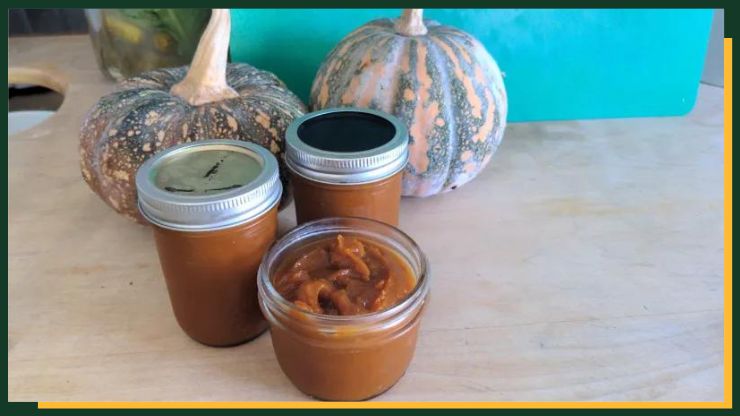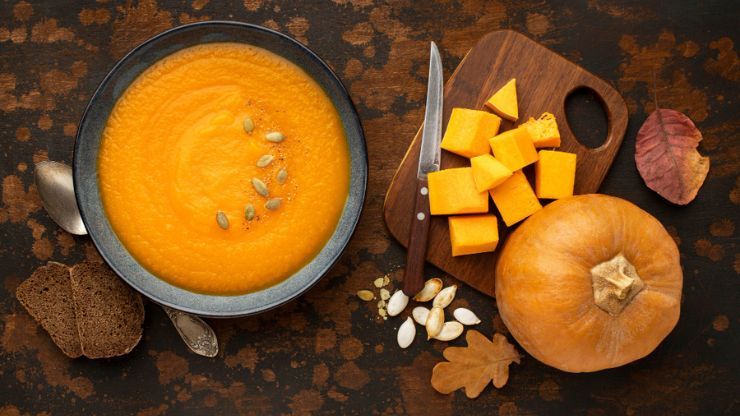Lacto-Fermented Pumpkin Butter is a delicious take on a traditional fall favorite that enhances flavor and nutritional value by utilizing the age-old technique of fermentation. By utilizing the transformational properties of lactic acid bacteria, this procedure improves the butter’s nutritional value and digestibility while also adding a distinct tanginess.
By combining the rich, earthy sweetness of pumpkin with carefully chosen spices and the magic of fermentation, this recipe promises a spread that goes beyond mere indulgence—it’s a probiotic-rich treat that nourishes both the palate and the gut.
Join the journey of crafting this fusion of tradition and innovation, turning a seasonal staple into a healthful, flavorful delight that adds a zing to your culinary repertoire.
Table of Contents
ToggleHealth benefits of lacto-fermented foods
Lacto-fermented foods offer a range of health benefits, making them a valuable addition to a balanced diet. Here are some key advantages:
- Probiotics: Lacto-fermentation encourages the growth of beneficial bacteria, such as Lactobacillus and Bifidobacterium. These probiotics support a healthy balance of gut microflora, aiding digestion and nutrient absorption.
- Digestive Health: The probiotics in lacto-fermented foods contribute to a healthy gut environment, potentially alleviating issues like irritable bowel syndrome (IBS) and promoting regular bowel movements.
- Enhancement of Nutrients: Certain nutrients may become more bioavailable through fermentation, which facilitates the body’s absorption of those nutrients. This includes B vitamins, minerals, and phytonutrients present in the fermented ingredients.
- Boosted Immunity: A significant portion of the immune system resides in the gut. Probiotics from fermented foods may enhance immune function, helping the body defend against infections and illnesses.
- Reduced Inflammation: Probiotics have been linked to reduced inflammation in the body. Chronic inflammation is associated with various health issues, including autoimmune disorders and cardiovascular diseases.
- Improved Mood and Mental Health: The gut-brain connection is well-established, and a healthy gut microbiome may positively influence mood and mental well-being. Some studies suggest a potential link between gut health and conditions like anxiety and depression.
- Lactose Digestion: Fermentation breaks down lactose, making lacto-fermented foods more easily digestible for individuals who may be lactose intolerant.
- Preservation of Nutrients: Fermentation acts as a natural preservative, helping to extend the shelf life of food without the need for artificial additives. This can be beneficial for maintaining the nutritional content of certain foods over time.
Also, Read – Fermented Pineapple Chutney
How to make Lacto-Fermented Pumpkin Butter

Ingredients:
- 4 cups of pumpkin puree
- 1/4 cup of whey (strained from yogurt) or use a vegetable starter culture
- 1 tablespoon sea salt
- 1-2 tablespoons of honey or maple syrup (optional, for sweetness)
- 1 teaspoon ground cinnamon
- 1/2 teaspoon ground ginger
- 1/4 teaspoon ground cloves
- 1/4 teaspoon ground nutmeg
Equipment:
- Mixing bowls
- Wooden or plastic spoon
- Glass jar with a tight-fitting lid
- A small glass jar filled with water or a fermentation weight (to keep the pumpkin submerged)
- Cheesecloth or coffee filter and rubber band
Prepare the Pumpkin Puree
To prepare pumpkin puree, cut a sugar pumpkin in half, remove seeds, and place halves face down on a baking sheet. Roast at 375°F (190°C) for about 45-60 minutes until the flesh is tender. Scoop out the cooked pumpkin and blend until smooth. As an alternative, you can cook or steam pumpkin chunks until they are tender. Ensure the puree is free of additives for optimal fermentation.
Also, Read – Art of Making Fermented Sausages
Combine Ingredients
In a bowl, combine 4 cups of pumpkin puree with 1/4 cup of whey or a vegetable starter culture. Add 1 tablespoon of sea salt and optional sweeteners like 1-2 tablespoons of honey or maple syrup. Enhance the flavor with 1 teaspoon of ground cinnamon, 1/2 teaspoon of ground ginger, 1/4 teaspoon each of ground cloves and nutmeg.
Thoroughly mix the ingredients to achieve an even distribution. To suit your tastes, adjust the spices and sweetness. This well-blended mixture forms the base for your lacto-fermented pumpkin butter.
Transfer to Jar
Pour the thoroughly combined pumpkin mixture into a sanitized glass jar, ensuring that there is a quarter of an inch of headroom. Compact the mixture to eliminate air bubbles. To ensure proper fermentation, place a fermentation weight on top or use a small, water-filled glass jar. This keeps the pumpkin submerged in its own juices.
Don't just scroll, subscribe!
BuzzTrail's unique web-stories are the cure for boredom you've been waiting for.
Cover the jar with a double layer of cheesecloth or a coffee filter and secure it with a rubber band. This allows airflow while preventing contaminants. The jar is now ready for fermentation in a warm spot (70-75°F or 21-24°C) for 2-5 days. Check daily and adjust sweetness or spices as needed.
Add Fermentation Weight
Place a fermentation weight on the pumpkin mixture within the jar. This weight ensures proper fermentation by keeping the pumpkin submerged in its juices. You can use a purpose-made fermentation weight or improvise with a small, water-filled glass jar.
The weight prevents air exposure and promotes an anaerobic environment necessary for lacto-fermentation. This step is crucial in fostering the growth of beneficial bacteria while inhibiting harmful microbes. It aids in achieving the desired tanginess and texture in the lacto-fermented pumpkin butter. As the fermentation progresses, regularly check the flavor and adjust sweetness or spices to suit your taste preferences.
Cover and Secure
Cover the jar containing the pumpkin mixture with a double layer of cheesecloth or a coffee filter. Secure the covering tightly using a rubber band. This arrangement allows necessary airflow for the fermentation process while acting as a barrier against contaminants. The permeability of the cloth or filter promotes gas exchange, aiding the growth of beneficial bacteria.
The secure covering ensures a controlled environment for lacto-fermentation to occur. Set the jar in a warm area (about between 21 and 24°C, or 70 and 75°F) to speed up the fermentation process. Regularly monitor the taste, adjusting sweetness or spices as desired, and proceed to the next steps once the desired level of fermentation is reached.
Ferment
Place the securely covered jar in a warm location, ideally around 70-75°F (21-24°C), to initiate the fermentation process. Allow the lacto-fermentation to occur for a duration of 2-5 days, depending on your desired taste and tanginess. During this period, beneficial bacteria will proliferate, transforming the pumpkin mixture into lacto-fermented pumpkin butter.
Check the taste daily, and when it reaches the desired level of fermentation, remove the fermentation weight. Seal the jar with a lid, and refrigerate to slow down the fermentation process. This step preserves the lacto-fermented pumpkin butter and allows it to be stored in the refrigerator for an extended period.
Transfer and Store
Once the lacto-fermented pumpkin butter reaches your preferred level of tanginess, remove the fermentation weight, seal the jar with a lid, and transfer it to the refrigerator. Refrigeration slows down the fermentation process, preserving the butter for an extended period. Store the jar in the refrigerator for several weeks, ensuring a cool environment for long-term freshness.
Enjoy the flavorful and probiotic-rich lacto-fermented pumpkin butter on toast, mixed into yogurt, or as a versatile ingredient in various dishes. Experiment with different spice levels and sweetness to suit your taste preferences.
Conclusion
In conclusion, the consumption of lacto-fermented foods stands as a flavorful and healthful practice. From promoting gut well-being and nutrient absorption to bolstering the immune system, the array of benefits extends beyond the palate.
Embracing the ancient art of fermentation not only enhances the taste of everyday staples but also invites a holistic approach to wellness.
As we savor the tang of each bite, we nourish our bodies with probiotics, fostering a symbiotic relationship between nutrition and health. Cheers to a journey where culinary pleasure intertwines seamlessly with the pursuit of vitality and balance.
FAQs
What foods can be lacto-fermented?
What foods can be lacto-fermented?
Common lacto-fermented foods include sauerkraut, kimchi, pickles, yogurt, kefir, and various vegetable and fruit blends. The possibilities are extensive, limited only by your culinary creativity.
How long does the lacto-fermentation process take?
How long does the lacto-fermentation process take?
The duration varies based on the recipe and desired flavor. Fermentation can take anywhere from a few days to several weeks. It’s advisable to taste the food regularly to achieve the desired level of tanginess.
Can lacto-fermented foods be stored?
Can lacto-fermented foods be stored?
Yes, after reaching the desired level of fermentation, store lacto-fermented foods in the refrigerator. The cold temperature slows down the fermentation process, preserving the food and maintaining its quality.

